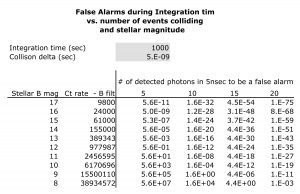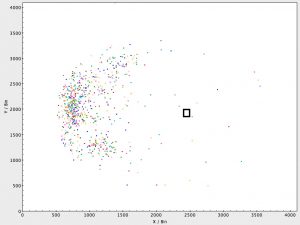(John Vallerga, April 21, 2016)
The Case for Optical SETI
The primary arguments in favor of conducting SETI at optical rather than radio wavelengths are:
- Transmitted beams from optical telescopes are far more slender than their radio counterparts owing to the high gain of optical telescopes
- Interstellar dispersion which broadens radio pulses is negligible at optical frequencies.
- The capability of radio transmitters has reached a stable maturity, while the power of optical lasers has not yet plateaued and has shown an annual Moore’s law doubling over the last 30 years.
- Natural and cultural background signals are negligible
- The instrumental complexity and computational power required for sensitive microwave ET searches is unnecessary for optical SETI. Detection can be simple using photon counting detectors.
We propose to look for ET signals from nearby stellar systems by assuming ET is aiming a high powered pulsed laser with pulse durations on the order of 5 nanosec, thereby being brighter than the host star for that very short period of time. Quick calculations show that if ET has a laser with an energy per pulse equivalent to that of the Livermore National Lab (1.8MJ/pulse in 2010) and it is launched through a space-based diffraction limited 10 meter telescope to aim at our Solar system, we could detect 10 photons per pulse using the SALT telescope and the BVIT detector for searches to a distance of 1 kiloparsec.
To detect such a bright pulse within such a short timescale, we use the BVIT cross delay-line (XDL) detector which has a pulse amplifier shaping time on the order of 5 ns. Multiple photon events within this timescale cannot be counted separately but would just increase the amplitude of this fast pulse. Of course, the normal photon event rate from the ET’s parent star would also have a statistical chance of multi-hit events and this would be a function of its stellar brightness (count rate). Thus, we must somehow discriminate between the very bright laser photon pulses from ET and the stellar photons that are detected within the 5ns amplifier shaping time.
The number of “false alarms” caused by photons emitted from the parent star for a given integration time T, for n detected counts to occur during a short time duration Δt for any region of the imaging detector is given by :
Rn Δt(n-1) T
where R is the photon count rate from the star, and T the total integration time. Below is a table that shows the expected number of false (stellar photon) alarms vs. magnitude from a single star for a threshold of 5, 10 and 20 concurrent photon events detected during that time at the same physical (X,Y) location on the detector. (Rates taken from McPhate’s SALT BVIT predictions).
For example, a 13th magnitude star would have a ~390kcps event rate on the detector and after a 1000 second integration, we would expect a probability of .0056 to have a false alarm if we threshold pulses with an amplitude a factor of 5 larger than a normal photon event. Clearly, the brighter the star, the higher the false alarm rate, so we require a higher threshold criterion to detect the ET laser pulses (i.e. more photons per pulse).
As an imaging MCP detector, BVIT cannot accept high local rates for the brighter stars nor can the MCP pulses differentiate large pulses from small ones at nominal gain when the MCPs are saturated. However, we can lower the gain of the MCP substantially by turning down the high voltage bias. Signal amplitudes then become linear with input number of photons. If we turn down the gain by a factor of 10 or 20, only larger pulses that have this many photons registered within the amplifier timescale of 5ns will be detected. Single photons will not trigger the MCP.
So, another example:
For a B(mag) = 11.0 star has a stellar photon count rate of ~ 2.45 MHz at normal detector gain. If we lower the gain by a factor of 10 we would expect to detect 1.6 x 10-8 triggers arising from false alarms from the star over an integration time of 1000 seconds at the star’s X,Y location on the detector. If we see an event at the star’s location, it is probably not due to stellar light pileup, more likely a cosmic ray. False alarms from cosmic rays are rare for a chosen stellar location but predicted rates are best determined in the field in order to discriminate such events from ET photons.
Strawman observation scenario for detection of ET photon pulses:
Setup:
With the BVIT on SALT turned on with nominal high voltage in the dark (shutter closed), a series of 50 second integrations are taken at different high voltages, decrementing the voltage by ~50V each time from the nominal operational voltage of 3000V. The pulse height data is analyzed to measure the Gain vs Voltage characteristics of the detector so that we can estimate the voltage required for the detector gains of 5, 10 and 20 less than nominal. This task can be performed remotely from Cape Town at any time previous to the actual scientific observation with BVIT
In early May 2016 we performed a Gain-Voltage test of the BVIT detector to determine the optimal (lower) high voltage of the BVIT detector when used for ET observations. From these data we determined that HV = 2500V is appropriate for ET observations.
Observing Log 05-13-2016 in Cape Town
Gain-Voltage Test of BVIT Detector
Det. Temp = +11.4C
Detector HV Filename Expo Time (sec) Buffer Size Total Cts
3000 160513-200840.fits 30 1000 287000
2950 160513-202252.fits 30 1000 329000
2900 160513-202726.fits 30 1000 293000
2850 160513-202943.fits 30 1000 232000
2800 160513-205126.fits 30 1000 135000
2750 160513-205600.fits 30 1000 45000
2700 160513-205845.fits 30 1000 6000
2650 160513-210317.fits 30 1000 3000
2650 160513-212307.fits 300 1 3123
2600 160513-213212.fits 300 1 143
2550 160513-214047.fits 300 1 41
2500 160513-214918.fits 300 1 8
2450 160513-215644.fits 300 1 4
2400 160513-220325.fits 300 1 0
2500 160513-221307.fits 1000 1 46
Science Observation:
On the sky, we go to a star of similar color to the candidate ET star but much dimmer, and calibrate our ND filters. For maximum detection sensitivity we do NOT require use of the B,V or R filters during these observations. With the appropriate ND filter in place, we move to the bright candidate ET star, confirming the count rate at nominal voltage. Using our false alarm estimates of detected stellar photons, we lower the voltage incrementally until we reach the correct gain such that the photon false alarm rate for the star is much less than one for the long (1000 sec?) integration time. With the gain lowered, we can now remove the ND filter and start integrations on the star field. We should probably do 3 integrations of ~ 2400 sec for each star field in case we detect actual ET events. We must also make sure we move away from the bright star or insert the ND filter before we raise the voltage back to nominal.
In order to confirm that the BVIT detector electronics does not introduce spurious events into the data acquisition system that could be mistaken for ET generated photons, a 1-hour long “dark field” integration should be performed at the low gain voltage at the end of the night’s observations.
Having one (or more) stars in addition to the target star within the 1 arc min FOV is an added bonus, since any detected stellar photons aids in the accuracy of placement of ET photons in addition to improving the statistical arguments in favor of detected ET photons
Observations of the ExoPlanet System Wolf1061
On May 14th 2016 we observed the star Wolf1061 using the BVIT operated at 2500V to search for laser generated photon events in the direction of the exoplanet Wolf1016. This planet lies in the Habitability Zone of the star and is of Earth-like size. We observed this system for a total of 2400sec, split into 3 separate observations of duration 600, 1200 and 600sec each.
Below we show the total number of events as recorded on the BVIT detector during the entire 2400sec observation, each event time-tagged to a few nanoseconds. The black box shows where the center of the stellar image lies of the detector, with errors of +/- 20 pixels. As can be seen, no events were detected within this box. From these data we can place meaningful lower limits on the power of a laser that could be present in that stellar system. The events on the left-side of the detector can be attributed to ion-feedback on the BVIT detector and can be discriminated by further data analysis.
Figure 1: Recorded events on the BVIT detector during a 2400 sec observation of the exoplanet system Wolf1061. The box is the location of the star. No evnets were recorded within that pixel box.


